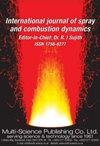Analytical approximations for heat release rate laws in the time- and frequency-domains
IF 2.1
4区 工程技术
Q3 ENGINEERING, MECHANICAL
International Journal of Spray and Combustion Dynamics
Pub Date : 2020-01-01
DOI:10.1177/1756827720930491
引用次数: 2
Abstract
This paper focusses on the relationship between the heat release rate and the acoustic field, which is a crucial element in modelling thermoacoustic instabilities. The aim of the paper is twofold. The first aim is to develop a transformation tool, which makes it easy to switch between the time-domain representation (typically a heat release law involving time-lags) and the frequency-domain representation (typically a flame transfer function) of this relationship. Both representations are characterised by the same set of parameters n1, n2, …, nk. Their number is quite small, and they have a clear physical meaning: they are time-lag dependent coupling coefficients. They are closely linked to the impulse response of the flame in the linear regime in that they are proportional to the discretised (with respect to time) impulse response. In the nonlinear regime, the parameters n1, n2, …, nk become amplitude-dependent. Their interpretation as time-lag dependent coupling coefficients prevails; however, the link with the impulse response is lost. Nonlinear flames are commonly described in the frequency-domain by an amplitude-dependent flame transfer function, the so-called flame describing function. The time-domain equivalent of the flame describing function is sometimes mistaken for a ‘nonlinear impulse response’, but this is not correct. The second aim of this paper is to highlight this misconception and to provide the correct interpretation of the time-domain equivalent of the flame describing function.在时域和频域中热释放速率规律的解析近似
本文重点讨论热释放率与声场之间的关系,这是模拟热声不稳定性的关键因素。这篇论文的目的是双重的。第一个目标是开发一种转换工具,它可以很容易地在时域表示(通常是涉及时滞的热释放定律)和频域表示(通常是火焰传递函数)之间进行切换。两种表示都由相同的参数集n1, n2,…,nk来表征。它们的数量很少,但具有明确的物理含义:它们是依赖于时间滞后的耦合系数。它们与火焰在线性状态下的脉冲响应密切相关,因为它们与离散(相对于时间)脉冲响应成正比。在非线性状态下,参数n1, n2,…,nk与振幅相关。它们被解释为依赖于时滞的耦合系数;然而,与脉冲响应的联系丢失了。非线性火焰通常在频域用一个与幅值相关的火焰传递函数,即所谓的火焰描述函数来描述。火焰描述函数的时域等效有时被误认为是“非线性脉冲响应”,但这是不正确的。本文的第二个目的是强调这种误解,并提供火焰描述函数的时域等效的正确解释。
本文章由计算机程序翻译,如有差异,请以英文原文为准。
求助全文
约1分钟内获得全文
求助全文
来源期刊

International Journal of Spray and Combustion Dynamics
THERMODYNAMICS-ENGINEERING, MECHANICAL
CiteScore
2.20
自引率
12.50%
发文量
21
审稿时长
>12 weeks
期刊介绍:
International Journal of Spray and Combustion Dynamics is a peer-reviewed open access journal on fundamental and applied research in combustion and spray dynamics. Fundamental topics include advances in understanding unsteady combustion, combustion instability and noise, flame-acoustic interaction and its active and passive control, duct acoustics...
 求助内容:
求助内容: 应助结果提醒方式:
应助结果提醒方式:


